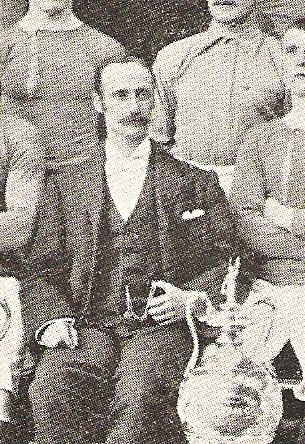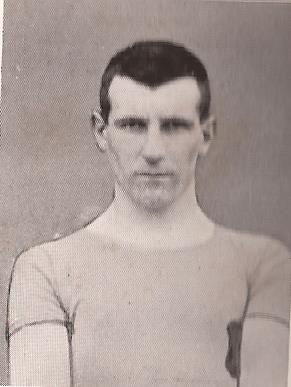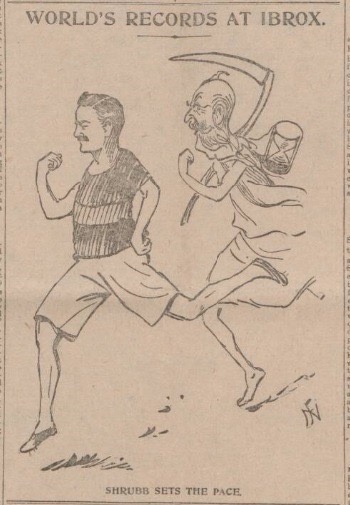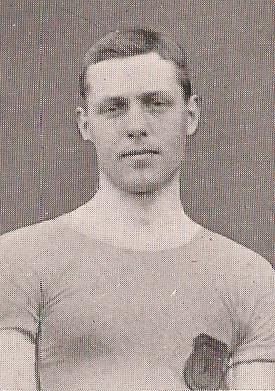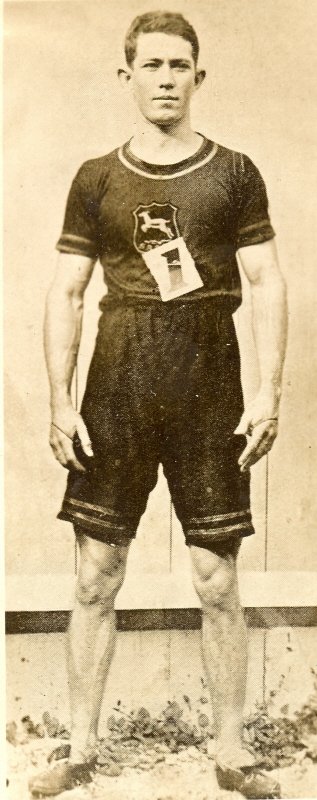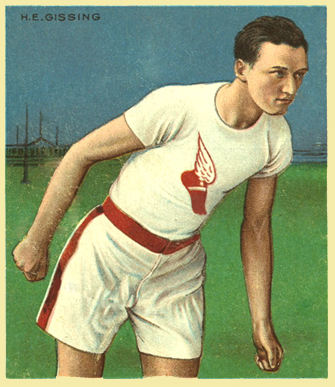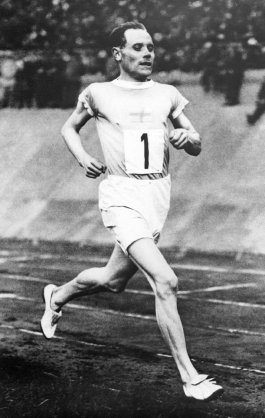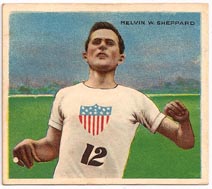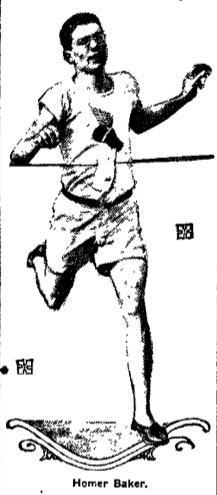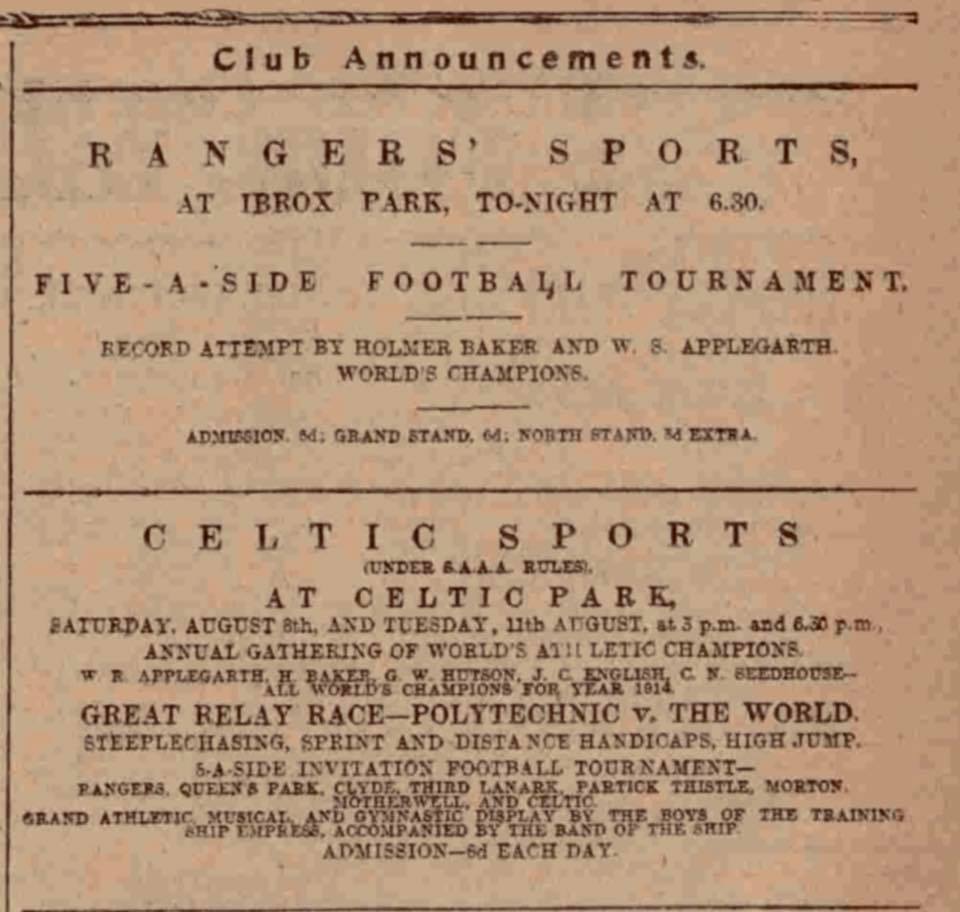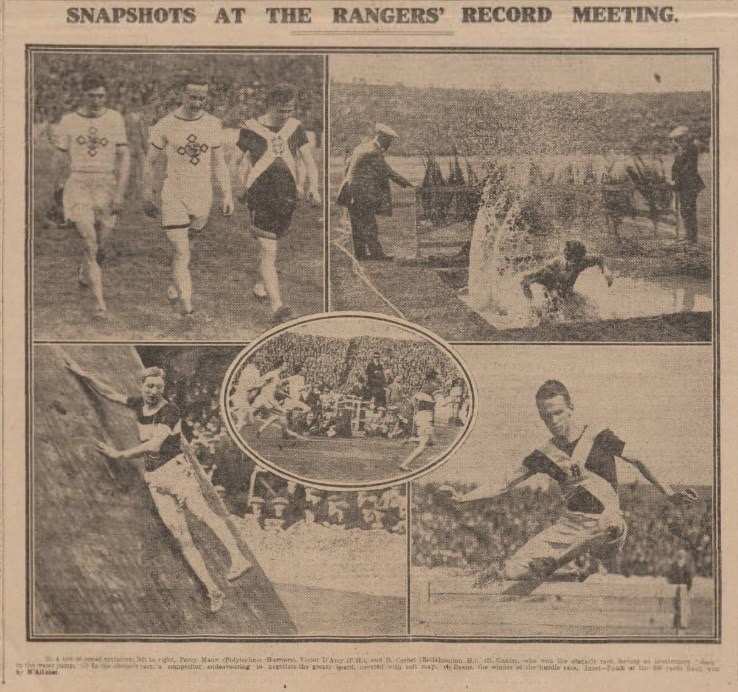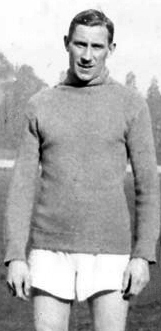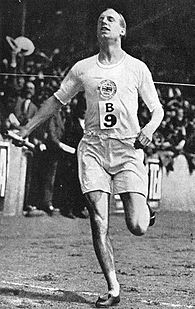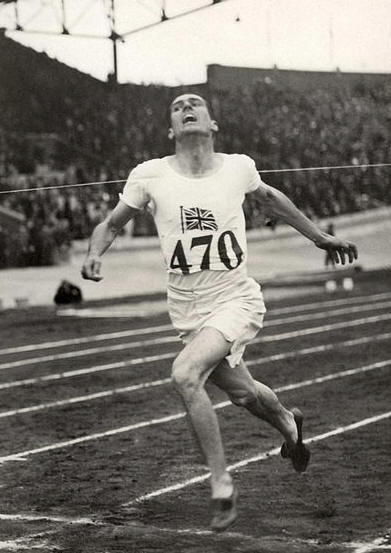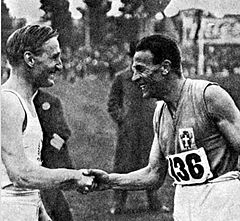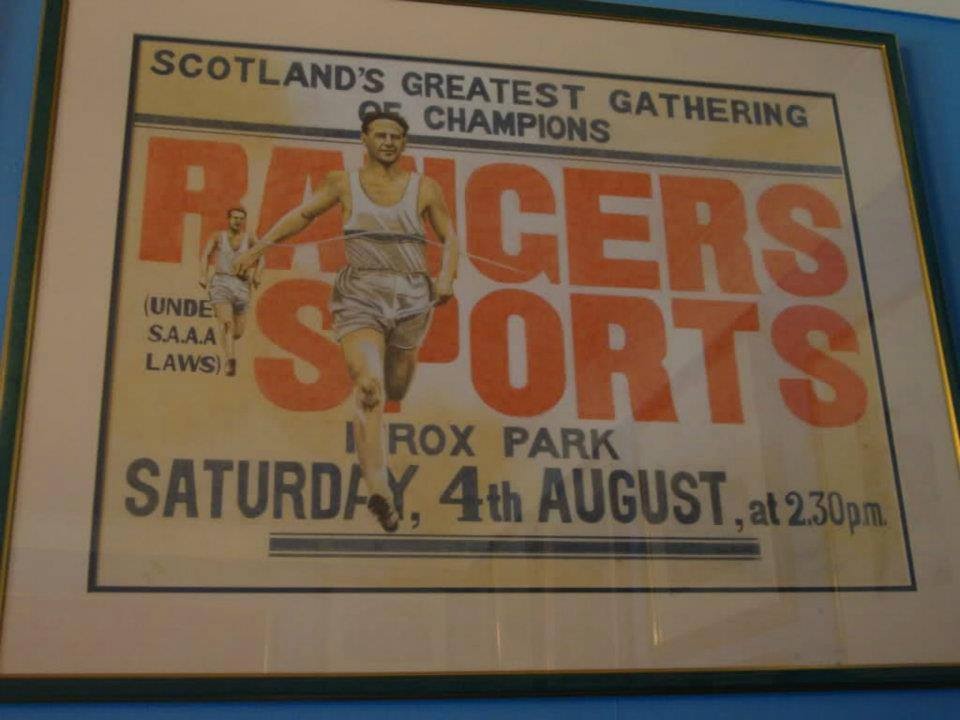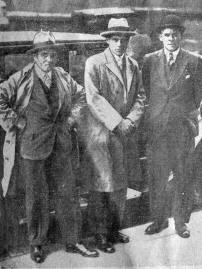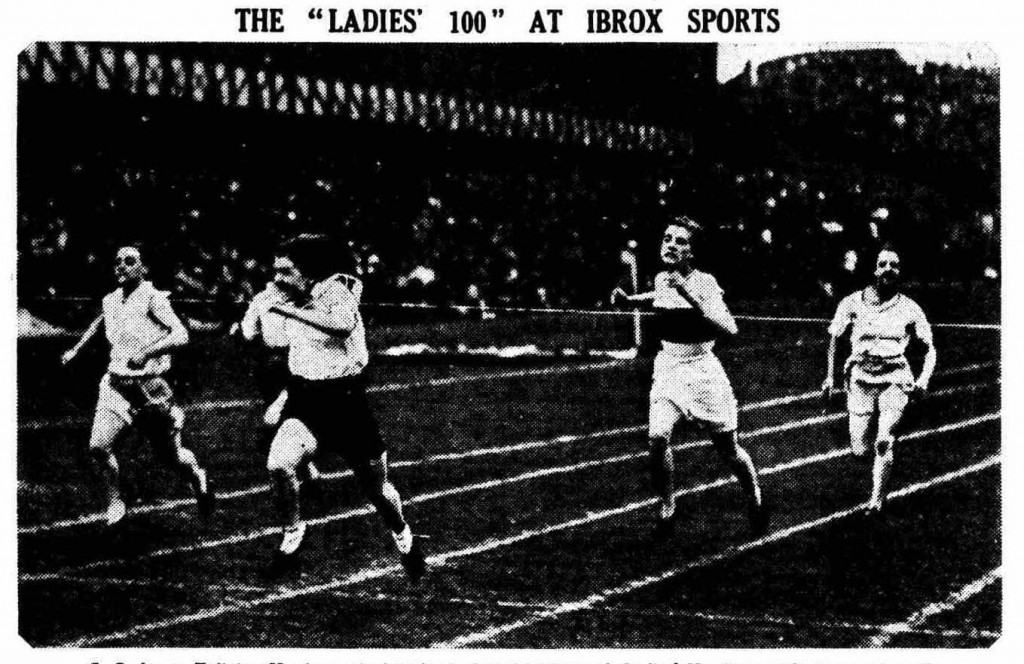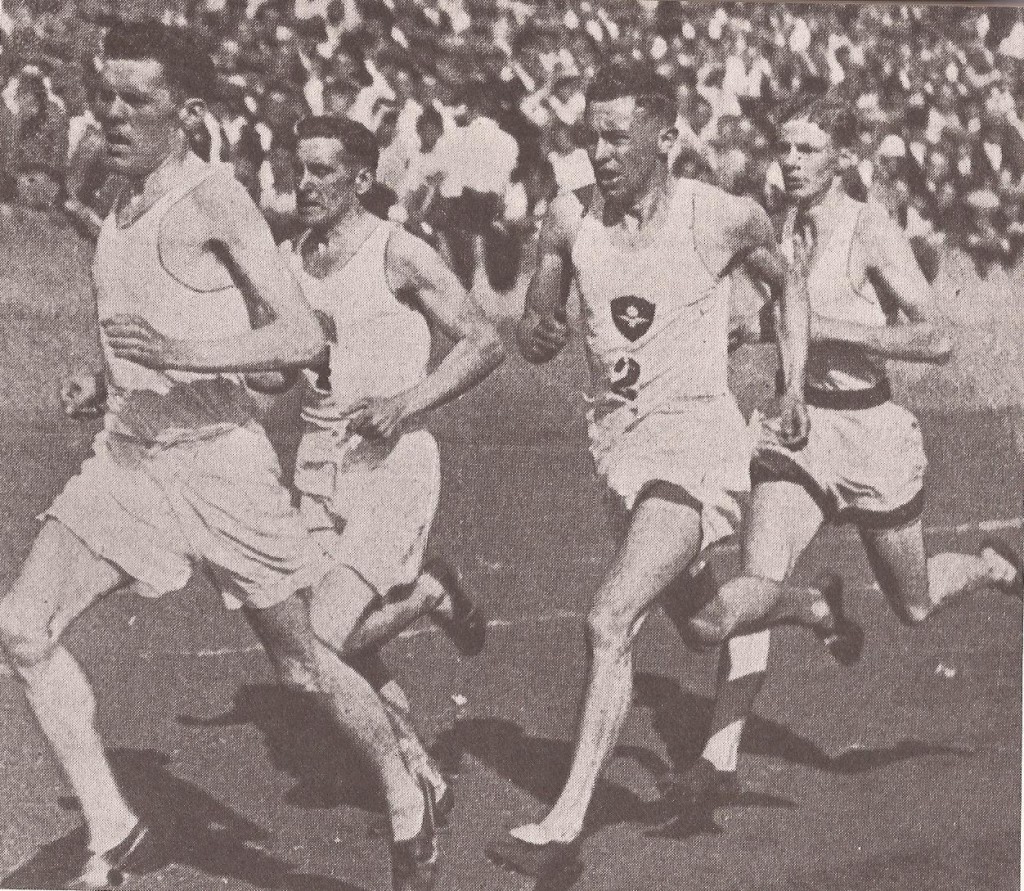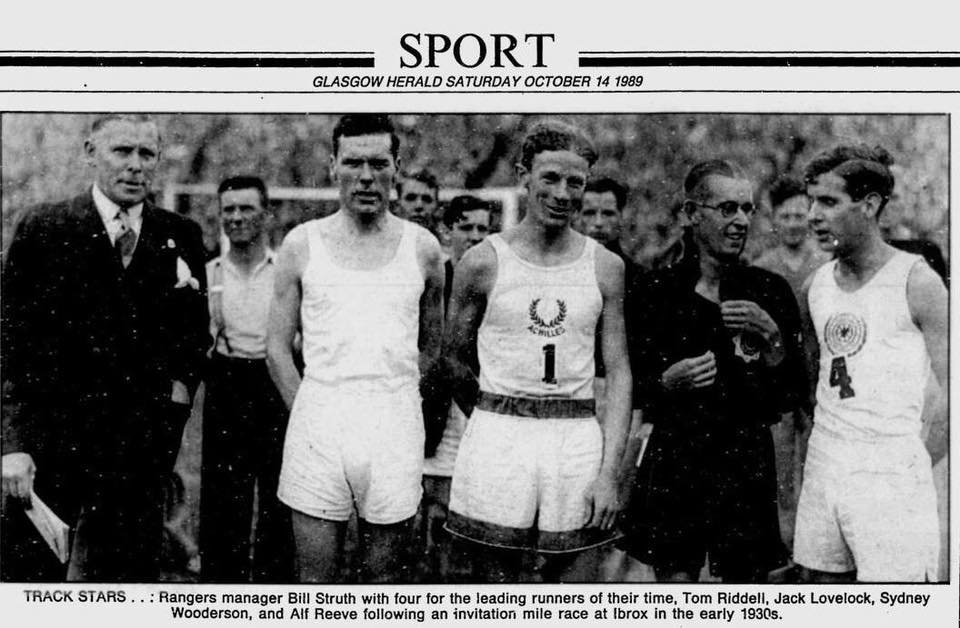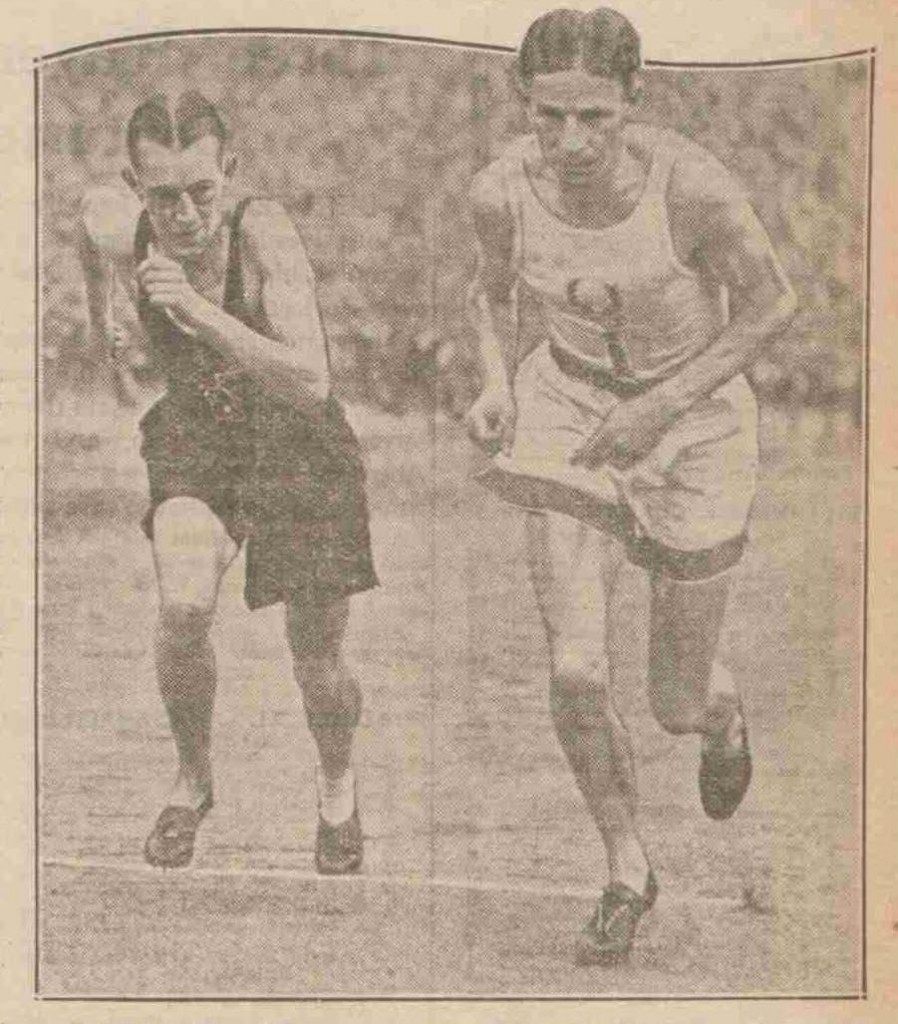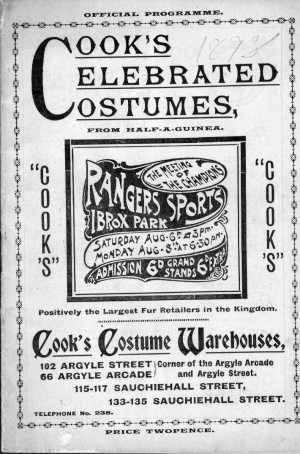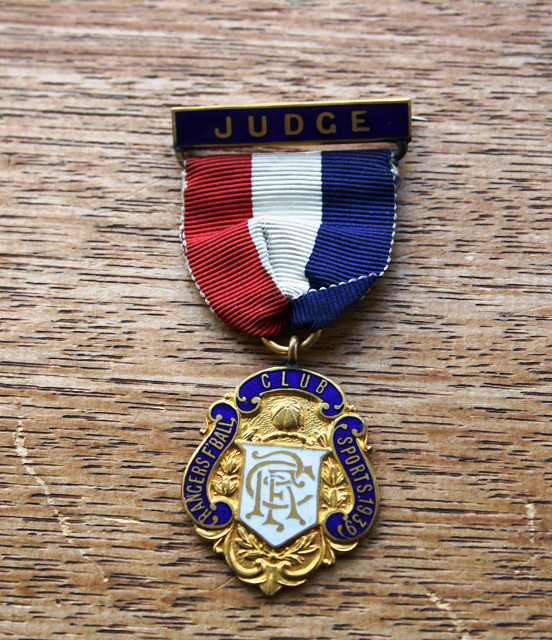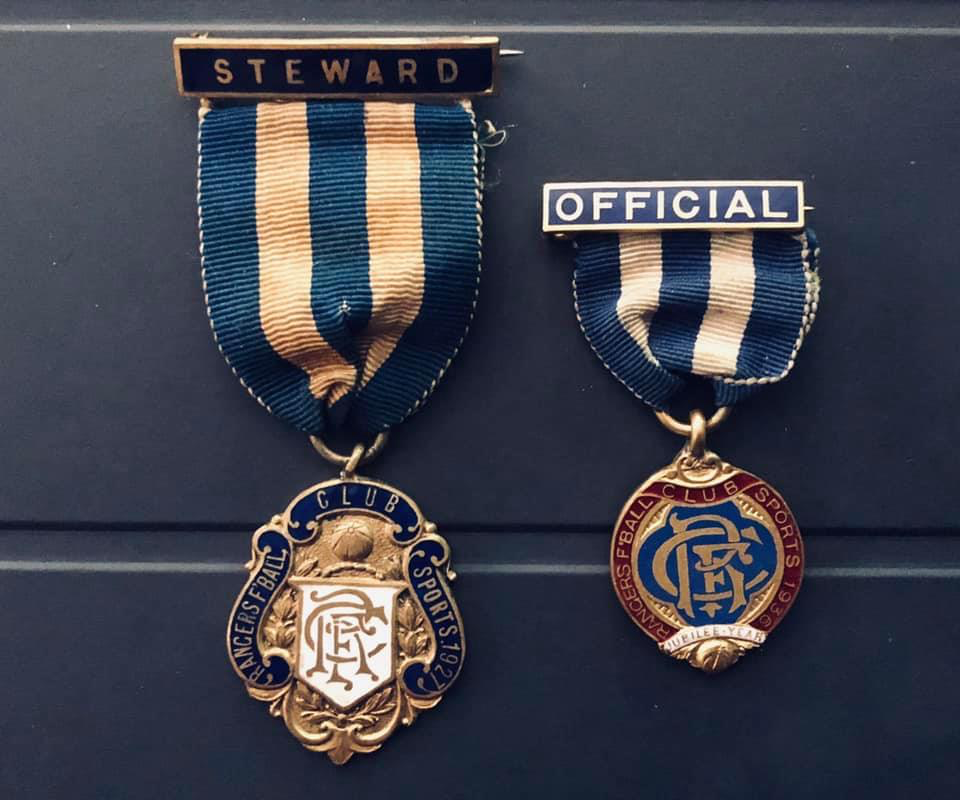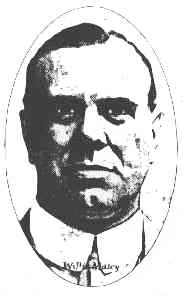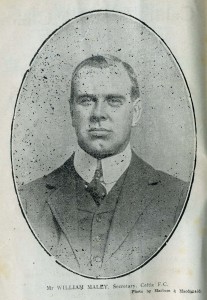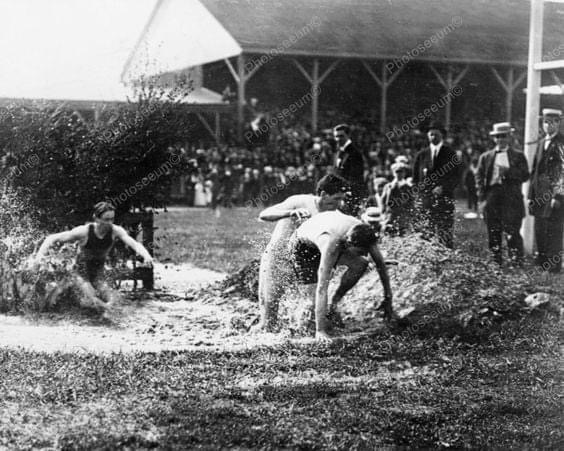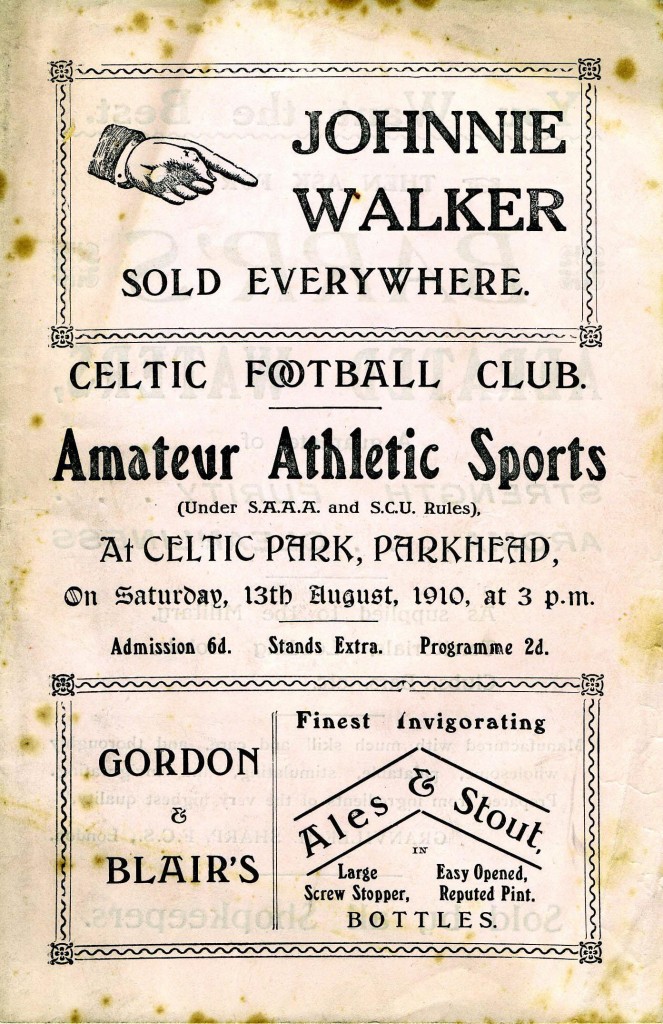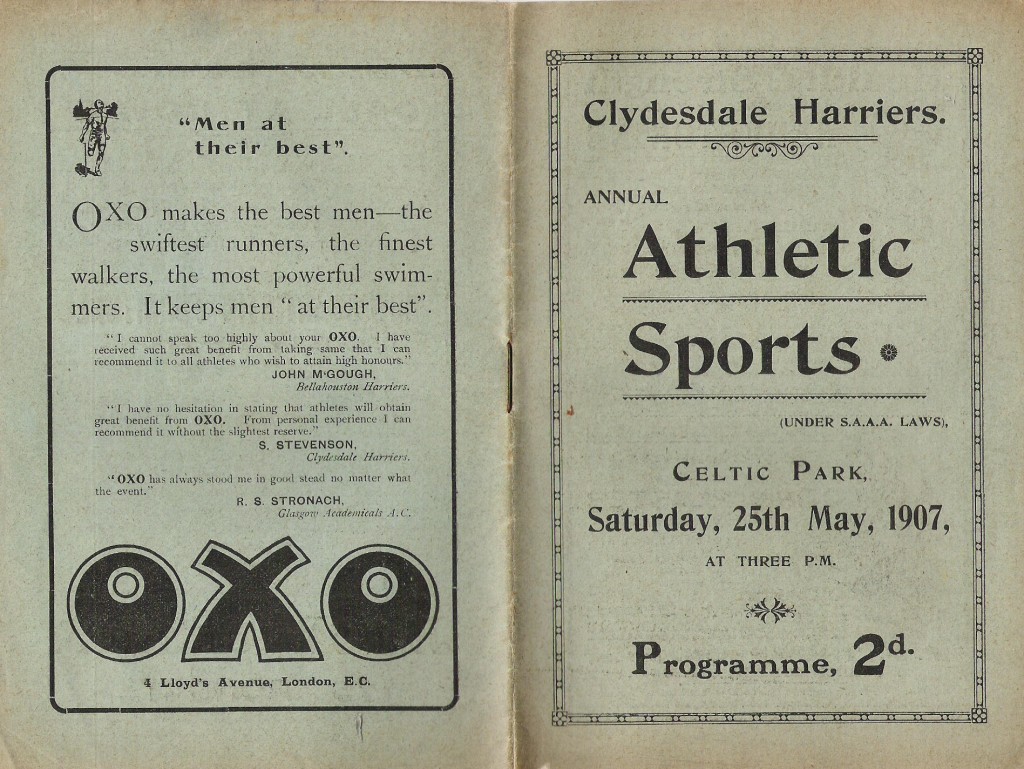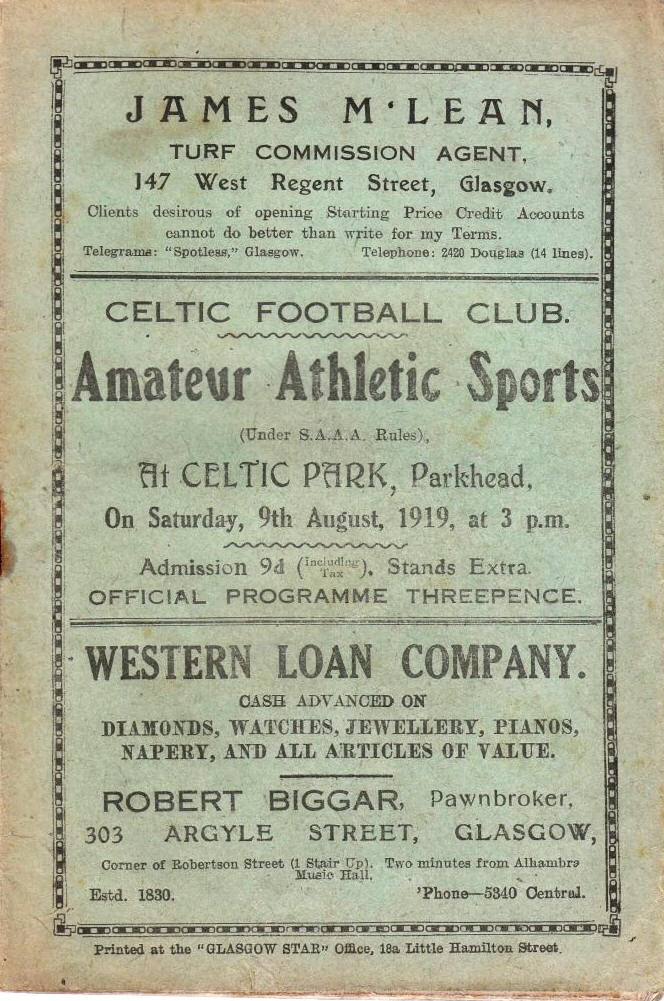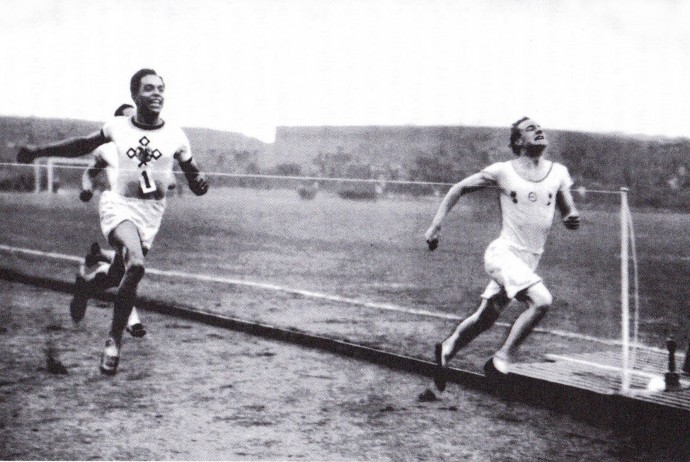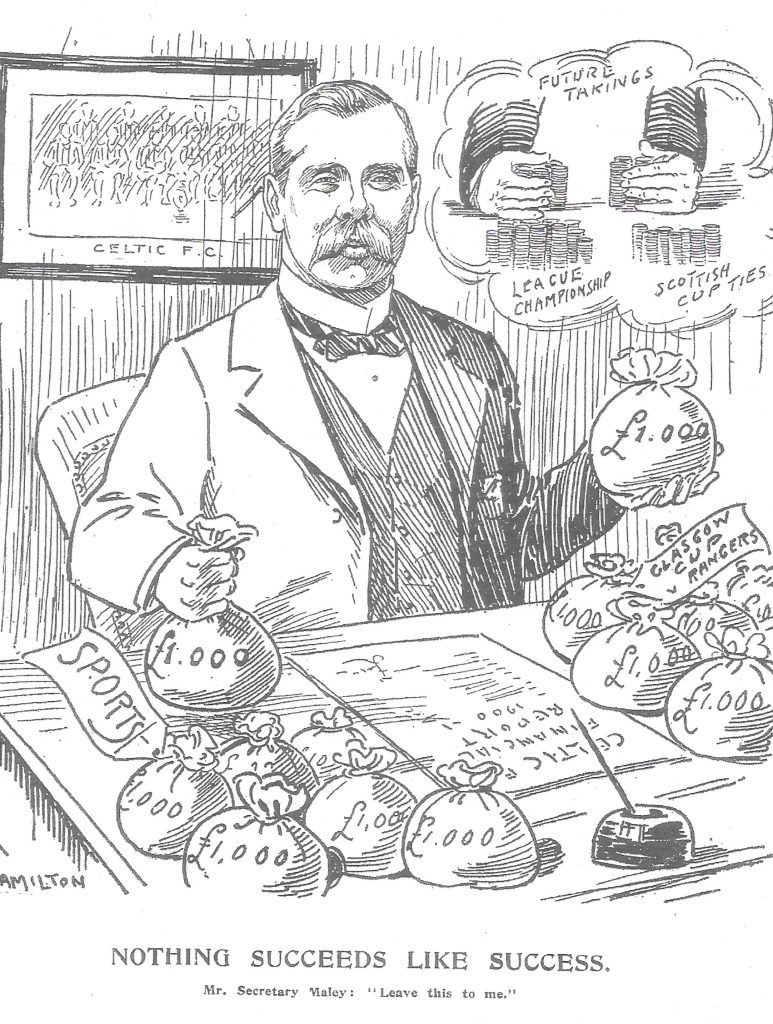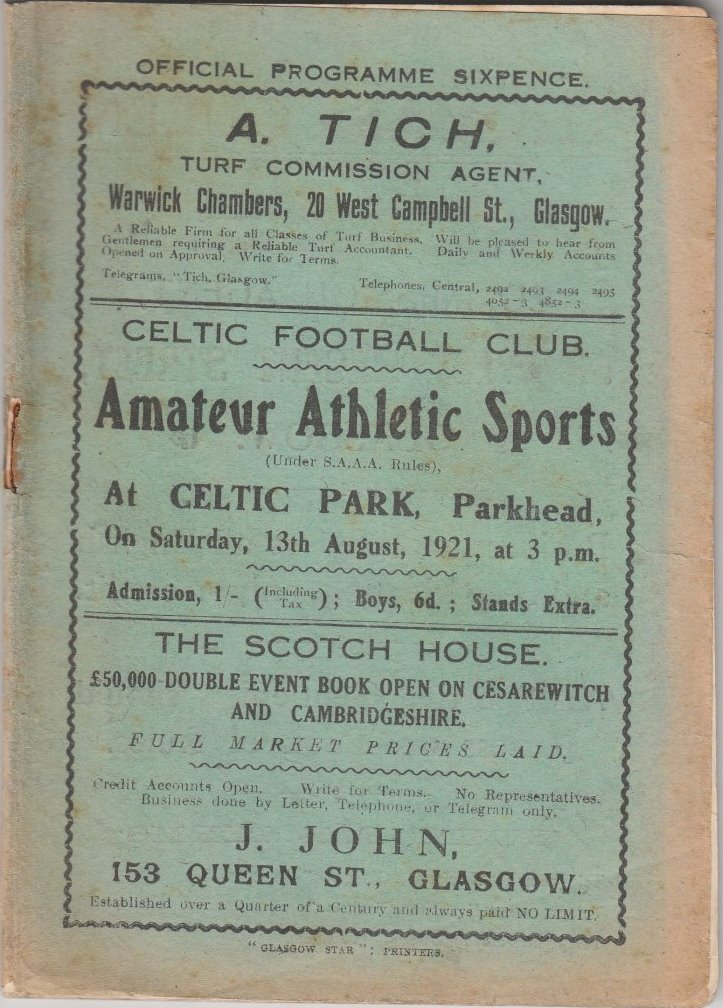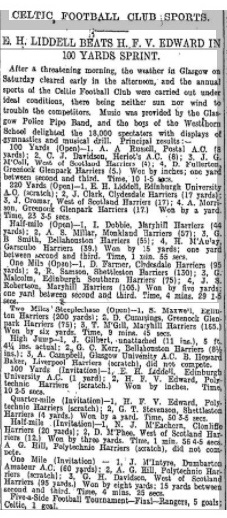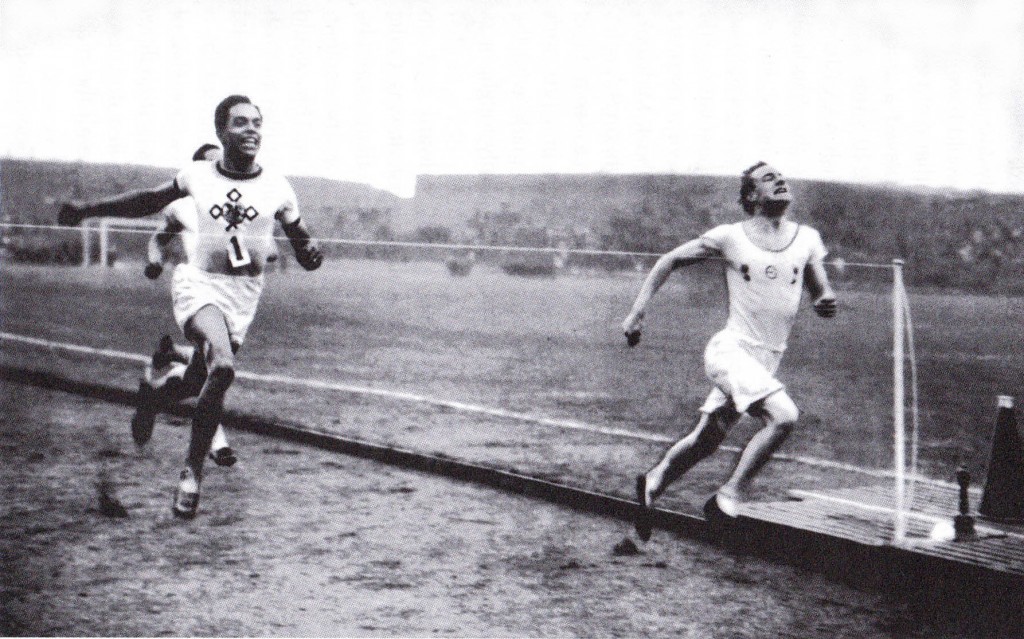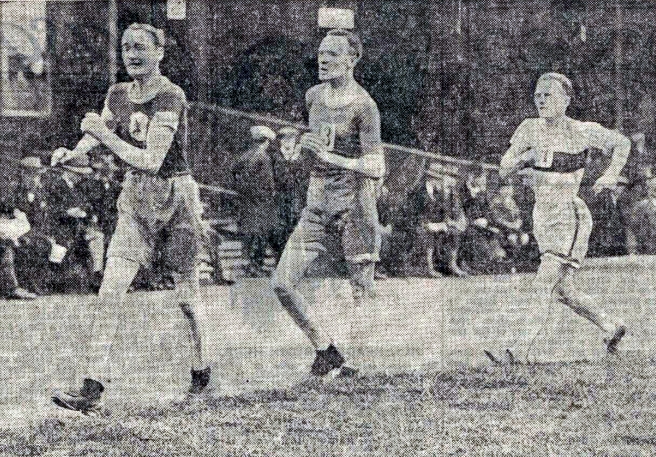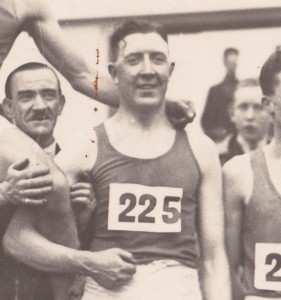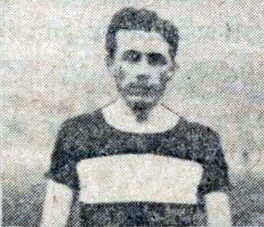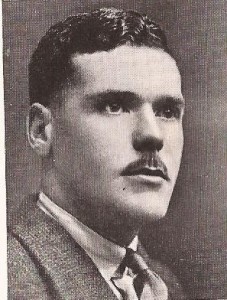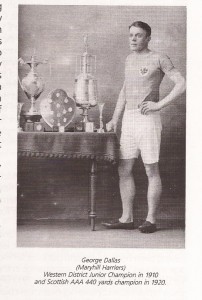William Wilton, the Rangers manager and secretary
Photo supplied by Iain Duff
To those of us who knew the Rangers Sports from the 1950’s to their sad demise in the 1960’s it is maybe surprising that the attraction of the event to the best in the world goes back to the very beginning of the twentieth century – and maybe further. The joint Clydesdale Harriers and Rangers Sports go back to 1888. It is only right then that we look at what was on offer to the people of Glasgow in the way of athletic entertainment at the turn of an earlier century and compare it with the start of the twenty first. It might well be to the detriment of the latter. Sports were on offer to the public from almost all of the major football clubs at the time, the oldest being the Queen’s Park FC meeting, including Partick Thistle and Clyde (a professional meeting for a long time) with the ‘big two’ of Rangers and Celtic always ending the season with their regular dates of the first and second Saturdays in August. It was also fairly common for sports meetings to be held over two days – Cowal Highland Games being the biggest recent example north of the border – and both Rangers and Celtic had Tuesday ‘supplements’ to the bigger Saturday occasions. Glasgow people then had big meetings on the two consecutive weekends with two more meetings with invitation races on the Tuesday following giving the people four good meetings in ten days. This page will deal almost exclusively with the Saturday meetings to give a picture of what was on offer by the big clubs, although the ‘supplementary’ meetings will probably be added at some date not too far into the future.
The first Rangers Sports of the twentieth century were held at Ibrox Park on 4th August, 1900. The ‘Athletics’ column started with coverage of the Strathallan Highland Games before going on to the Rangers FC Sports. There were eight lines of reportage plus results of the events held, before going on to the Clyde FC Sports, which were compared to those held by Third Lanark a week previously. The report on the event, which had an estimated 10,000 attendance, read: “The Rangers FC were favoured with the finest weather conditions for the initial portion of their annual sports meeting on Saturday afternoon, with the result that a large and fashionable gathering assembled. Both for the flat and the cycle events the competitors turned out in good numbers and splendid sport ruled throughout. J Watson, Hamilton, who won the 100 yards off six and a half yards, ran cleverly in Heats and Final, and the same may be said of DL Turner, Greenhead Harriers who had first place in the 300 yards off a short mark. Though both the half and one mile handicaps filled well, the contests were not in any way noteworthy, the majority of the starters being well beaten long ere the finishing straight was reached. … “
In 1901 the event took place on 3rd August. “The racing, both foot and cycle, at the Exhibition on Saturday was exceptionally interesting and the Rangers are to be congratulated not only on the way the meeting was arranged but on the large amount of support they received from the public. The most popular win of the day was McLean’s in the 220 yards handicap. He ran even better than he did in the International between Scotland and Ireland on the same track a few months ago. The Scottish champion is one of the best men n the country over the distance and it will be interesting to see how he fares with Long and Wadsley at the Celtic sports this week. Of course he will be getting a start from these men but it will be a small one in view of his form at the Exhibition on Saturday. ….
It was almost entirely a domestic field but entries were more than healthy – eg 105 for the 100 yards – but in terms of quality the club had to give best to Celtic at this point. The difference was called Willie Maley who would go looking for talent to the AAA’s championships and entice athletics to the Celtic Sports. There was a note in the Glasgow Herald that contained the report on Rangers Sports which commented on the ‘elaborate arrangements made by Mr Maley’ which had resulted in several Americans being the trump cards at their meeting the following week. The position would be at least emulated, and probably exceeded, when Bill Struth took over at Ibrox and of course the Rangers version lasted much longer than their rivals.
1902 was Coronation year and Rangers Sports were not held for the simple reason that the coronation was held on that very Saturday. The ‘Glasgow Herald’ article began “London, Saturday night. Morning had barely broken when the booming of the guns from Hyde Park awoke the Metropolis to the fact that Coronation Day had come. So long looked forward to, so anxiously anticipated, so unexpectedly and dramatically delayed, the day had at last arrived when the solemn ceremony and enthronement of Kind Edward and Queen Alexandra was destined to take place ….” Then followed eight broadsheet pages covering every conceivable aspect of the coronation, with several line drawings and notes on how the various communities were celebrating. On what should have been Rangers Sports day, there was a service of praise in Glasgow Cathedral in the forenoon, there was a luncheon in the Banqueting Hall of the City Chambers with guests invited by the Council, banks, the stock exchange and many other businesses were closed. And there were all the local celebrations as well. So – no athletics at Ibrox on the first Saturday of the month. The ‘Glasgow Herald’ said that the Rangers date had been taken by Wishaw Cycling Club for a one-off sports meeting, there were several such as part of the jollifications.
The following year, on 1st August, 1903, had a tale of excellent sport however with two Scottish records set – one at 100 yards and one in the hammer event. The report read “This was the most important meeting in Scotland , for which the Rangers executive made faultless arrangements. The programme was rich in talent and nearly all of the champions in their own department of athletics were present from England, Ireland and Scotland – also Arthur F Duffey of Georgetown University, USA, who holds the world’s record in the 100 yards flat race. The meeting was held on Saturday afternoon at Ibrox Park, and while the weather was not all that could be desired, the attendance was satisfactory.”
Duffey was considered the fastest man in the world at the time. He had run as favourite in the 1900 Olympics but despite a very good run in the Heats had to pull up in the final with an injury. American 100 yards champion in 1899, he won the AAA’s in England four times between 1900 and 1904. He ran 9.6 for 100 in 1902, a world record, but after a quarrel with the AAU over his refusal to wear Spalding running shoes he was found guilty of breaking the amateur code. There is genuine dispute over this verdict – the AAU President worked for Spalding Shoes and it was after the refusal to wear these that the President brought the accusation. There seems to be little if any evidence that he did actually do a bad thing! However, when he came to Ibrox in 1903, he was still a world class athlete.
How did Rangers manage this coup? The ‘Glasgow Herald’ again. “Recognising that athletics in the city is not in as healthy a condition as they might be, the Rangers this season resolved to do something to improve matters. Mr Wilton, in the first place was given a free hand, and that gentleman, with the cordial support from his directors, entered into negotiations with several athletes who had distinguished themselves within their respective spheres, with a view to quickening public interest, and at the same time enriching their exchequer, and how he succeeded may be guessed when we mention that the attendance on Saturday, despite the fact that the weather was by no means inviting, was little short of 13,000. The cash drawings in fact totalled £390 which from every point of view must be considered highly satisfactory. From first to last the sport was brilliant.
Even the most captious in matters athletic were constrained to deal in superlatives, and no higher testimony than this could be offered to the character of the sport. That matchless sprinter, A Duffy, won the 100 yards invitation handicap in a way that will never be forgotten by those who can appraise such performances at their top value. JP Stark, of the Glasgow High School, with a concession of five yards, pushed the American to the last foot – indeed it was only in the last few yards that he caught Stark and won in 9 4-5th seconds. …. Duffy had a great reception at the end of the race and equally cordial was the reception of Stark’s plucky effort. …
Marvellous improvement was demonstrated in the mile handicap by AM Watson of Edinburgh Harriers. Quite recently he beat McGough off 95 yards, and at the Shamrock CC Sports a few days ago, the Scottish champion gave Watson 80 yards and a handsome drubbing, but on Saturday the latter, with the same mark, won as he liked in 4 min 27 2-5th sec which is fast running when we allow for the weather and track conditions that prevailed. All things considered, McGough ran up to his best form , although he only did 4 min 30 sec, and the natural inference is, therefore, that Watson must have improved greatly since the Shamrock Sports. JJ Daly preferred the half-mile to the mile, and it must be confessed right away that he made an excellent appearance. He won his Heat all-out in 1 min 59 4-5th sec, and in the final finished third, Roxburghe, the winner doing the same time. …
TR Nicolson threw the hammer 151′ 6.5″, which is a new record, the previous best being 149′ 4″ at the international between Scotland and Ireland last month. … “
So a good meeting financially, with a good crowd and top class athletics.
JP Stark, West of Scotland Harriers, Four Times Scottish Champion
August 4th, 1904 was the date to visit Ibrox if you wanted athletics that year. The preview in the ‘Glasgow Herald’ of Monday 1st August read as follows. “Enterprising as the Rangers always are, they have excelled themselves in the arrangements they have made for their annual amateur sports, which fall to be celebrated this week-end. “Half-heartedness”, if the language of fiscal discussion be not out of place, the Rangers have never been, and it will certainly be no fault of Mr Wilton and his directors is Saturday’s meeting does not take a very high place in athletic records – if, in fact, it does not eclipse anything and everything that the Rangers have attempted in the way of presenting sports. The programme is large – perhaps too large – and it will tax the resources of the management to dispose of all the items within a reasonable space of time. There are two invitation handicaps – the 100 yards and 300 yards – which should excite considerable interest. Both will have a pronounced international colouring. We all remember the brilliant performance of AF Dudley at Ibrox last year when he did the 100 yards in 9 4-5th seconds, and if the American is scarcely so speedy now as he was then, he is possessed of a turn of speed which few can equal. The 300 has been included in the programme with the view of seeing Jupp over the distance which he likes best. Hyman and Westney will also run in this race and the interests of Scotland will be confined to RL Watson and WH Welsh, who from the fact that they are both good quarter men, should find the 300 yards to their liking. It is still doubtful if A Shrubb will be among the competitors, he has engagements to keep which have been entered into early in the season, but pressure from an influential quarter may make him alter his arrangements, in which case we shall have a fine exhibition of distance running from him, John McGough of Bellahouston Harriers, and Butterfield of Darlington. In addition to others of lesser note, Tom Nicholson will meet Shevlin of Yale in the hammer under stirrup-handle conditions, and O’Connor will take part in the jumps along with RG Murray, J Milne, D McRae and a host of others.”
These were all fine competitors with Scottish champions and record holders meeting top men from other nations. The report the following week was fulsome.
“Seldom if ever have so many noted athletes, foreign and native talent, been gathered together as were seen on Saturday afternoon within the Rangers model and commodious enclosure. It was the work of many weeks in compiling a programme so rich in talent , and Mr W Wilton, the Rangers manager and secretary, is to be congratulated on his successful efforts and for his successful handling of the reins on Saturday when everything went off without a hitch. The handicapping of Mr R Livingstone was perfect, all the finishes being close. In all there were 21 items and the entry was a record one for the Rangers. The 100 yards flat race alone brought out a field of 200, divided into 30 preliminary Heats, all associated with fast times, and 5 semi-finals ere the final was reached.
In the great international 100 yards invitation race, amongst others there competed such well-known flyers as JS Westney, New York AC, who had two and a half yards from AF Duffy, Georgetown University, and JW Morton, South London Harriers, who were at scratch; HA Hyman, Pennsylvania University, 2 yards, JP Stark WSH, two and a half yards, WH Welsh, Edinburgh University, 4 yards, RL Watson, WSH, three and a half yards, AG Rutherford, Kennedy College, and E Green, Sefton Harriers, each with eight and a half yards. The first prize fell to Stark after a notable effort. RS Stronach and T Nicholson each created records in the hurdles and hammer throwing respectively. …As expected, Shrubb did not appear and the mile was won by Butterfield (15 yards) from Craig of Bellahouston (120 yards), with McGough third (scratch).
The 100 yards had to be the best race of the day with four Americans, two Englishmen and three Scots with the winner a home Scot in 10 seconds dead.
*Hyman was a high hurdler with a high reputation and
*Westney was a genuinely fast sprinter, almost Olympic class with victories at distances as short as 70 yards up to 220 yards back home in the States;
* Duffey had of course held the world record with a time of 9.6 seconds. * JW Morton of SLH made the headlines in 1904 when he defeated Duffey at the AAA’s Championships and the US headlines all told the same story “Arthur Duffey Meets Defeat” rather than “Morton Wins”!
*WH Welsh had done the triple of 100, 220 and 440 at the SAAA’s in 1900, * JP Stark had won the SAAA 100 yards in June 1904 and been second in both 100 and 220 in the Irish International in July of that year.
No further comment on the quality required.
Although we are dealing here with the Rangers Sports, there was another wonderful evening of athletics at Ibrox in November 1904 when Alfred Shrubb set a world record for the one hour run plus a host of other records for shorter distances en route. Read a contemporary account here
Most of the domestic sprinters above would be competing at the 1905 version of the sports but the American contingent would be altered since there was an American party of athletes in Britain at the time. Again hopes were raised that Shrubb would be present, in which case there would be three scratch runners in the mile raising the prospect of a ‘rare dust-up’. The top American hurdler Amsler was said to be running raising the prospect of a meeting with the Glasgow Academical and WSH Harrier RS Stronach. Mr Wilton had received many entries just a week before the meeting and more were expected in the run-up. EA Amsler was a student from Princeton who was a record-breaking 120 yard hurdler on tour in Britain at the time.The report on the actual meeting read:
“BRILLIANT SPORT AT IBROX
From an athletic point of view, the Rangers FC scored a brilliant success with their sports on Saturday, but in other aspects the evidence of public apathy were again very apparent. The attendance, including the holders of paper admission, did not reach 8000, and this is scarcely a creditable response on the part of the citizens in view of the alluring attractions which were provided, mainly through the instrumentality of Mr William Wilton, secretary of the club. One record was broken and the honour fell to T Nicholson, who threw the hammer 153′ 3″, or one and a half inches better than the previous record established at the championships of 1904. Then in the hurdles, RS Stronach, in addition to defeating the American for the third time equalled his Connell Cup record, 15 4-5th sec. The Glasgow Academical is perhaps the most consistent performer there ever was in connection with hurdling, which from its very nature, does not lend itself to uniformity of motion and that fact makes his running all the more noteworthy. At the championships at Ibrox, at Ayr during the Fair Holidays and at the international match with Ireland, he did 16 sec, while at the Connell Cup contest and at Ibrox on Saturday he did 15 4-5th sec.
McGough for the second time in six days, got the better of Geo Butterfeld, who, in the mile on Saturday as in the mile and a half on Monday last, lost first place by inches only. It was a strenuous effort on the part of both, and the one was as cordially applauded as the other on retiring to the dressing room. The time in the special handicap was 4 min 27 sec and in the open handicap 4 min 26 2-5th, which shows that the latter was not any more difficult a task for the scratch men than the former. The 300 yards invitation handicap was all that was anticipated, except that the record did not go, and in such conditions this was scarcely to be looked for. Hyman just managed to beat C McLachlan of Blackheath Harriers at the post in 31 4-5th while Taylor, the coloured American, was third, just a foot behind. It was a fine race and will remain for some time to come one of the cherished recollections of Saturday’s meeting. The open and invitation specials were replete with interesting finishes, the finals in each case being as close as it was possible to make them. JP Stark captured the invitation. C McLachlan did wonderful day’s work winning heats in the first and second rounds of the open 100 and getting third in the final, second in the 300, second in the invitation sprint, in other words he covered 800 yards in all.
RS Stronach
The big attraction in 1906 was not American, English nor even Irish, although all three countries were represented – it was a Scotsman. Lt Wyndham Halswell was the man in question. Halswell had ‘done the treble’ of 100, 220 and 440 yards in the SAAA Championhips at Powderhall in June and won the 220 and 440 in the Irish International in July. Stark had won the 100m in the International after being second to Halswell in the championships. They were both in action at Ibrox in August. There was disappointment that Halswell did not break the record in the quarter mile but his time of 50 1-5th with a headwind up the finishing straight. Stark won the 100 yards invitation race in what was said to be his best ever performance and ‘gives him a position little short of that which AR Downer holds in the annals of Scottish athletics’. He was timed at 10 seconds from one yard with a yard covering seven runners at the post. McGough won the half-mile: he was in great form having won three races in a week – a mile and a half at Parkhead in 7 minutes on the Monday, won the mile at Larkhall in 4:27 and at Ibrox won the half mile in 1:58.8.
From the ‘Glasgow Herald’ of 27 July, 1907: “The Rangers are making very elaborate arrangements for their meeting on Saturday and Monday next, and it will not be their fault if the season does not end in a blaze of athletic fireworks. Being believers in the ‘star’ system, which has done so much for the popularising of athletics in the past, they have issued invitations to several leading pedestrians in England, and have received acceptances from some of the foremost amateurs. It so happens that the bulk of the acceptances are old favourites; but one or two have enhanced their reputations since last they were in Glasgow. Of these the most noted are JP George and EH Montague both of South London Harriers. The former achieved a brilliant win in the 220 yards championship at Fallowfield, Manchester, quite recently, while the latter, in the absence of Lieutenant Halswell, won the 440 yards championship. …. ” Other English star turns were noted but no Americans were mentioned in the preview. On the day in question, 12000 spectators turned up to see the action, and saw two fine invitation handicaps – over 100 yards and over 440 yards. There were eight starters in the 100 yards including the two favourites JW Morton and JP George but neither of them won. The race went to D Johnston of Bellahouston (‘who always manages to run well at Rangers Sports’) in 10.1 seconds. In the quarter-mile,“JP George would have won had he not been pocketed at the pavilion. As it was many thought that he was first, but the judge could scarcely be blamed for giving a tie, as the finish was exceedingly close, and the pace fast as the time shows. Vallance ran a plucky race, as indeed he always does, and his success was no less cordially received than was George’s.” The race was a dead-heat between George (6 yards) and J Vallance (Bellahouston, 12 yards )with a winning time of 49.8.
In the open races, Somerville of Motherwell won the four miles from SAAA Champion A Duncan and the mile was won by A McPhee of Paisley. The quality was undoubtedly in the sprints.
*
In the Rangers Sports of 1908, held on 1st August, the sprints were her highlight with Olympic champion of that year Reginald (Reggie) Walker from South Africa running. Walker was born in March 1889 and was the 1908 Olympic champion. He was the South African 100 yards champion but could not afford to go to London for the Games. A Natal sports writer raised a fund to pay for him to come to London, and once there he was coached by Sam Mussabini. He won his 100m first round in 11.0 seconds, his semi-final in 10.8 and the final also in 10.8, which tied the Olympic record. He was still in 2012 the youngest ever winner of the Olympic 100 metres. To have him at Ibrox in the Rangers Sports in 1908 was indeed an attraction.
“There was a considerable amount of character in the Rangers Sports at Ibrox on Saturday. This to some extent was anticipated with so many eminent athletes competing, but in several of the events, expectation was more than fulfilled, and that meeting, taken as a whole, will rank as one of the best that Rangers have provided in their long career as sports promoters. Again the sensitiveness of sprinting form was admirably illustrated in the 100 yards invitation handicap, which was won by JP Stark, the Scottish champion, in time which if correct makes him quite as smart as Reginald Walker, the Olympic winner. At all events he beat the South African handsomely at Ibrox on Saturday with a concession of three yards, and whatever may be said of the time, 9 3-5th seconds, it will be admitted that the Scotsman ran as he perhaps never did in his whole experience. Even in the open 100 yards, he disclosed rare pace winning the first round in 9 4-5th seconds, the second in 10 seconds, while in the final he had the misfortune to break down and failed to finish. It will be seen from these “times” that in each succeeding spin, the Scotsman was a couple of yards slower, and in the face of that, few will accept without some hesitation the 9 3-5th in the invitation race.
Walker was seen to better advantage in the open than in the invitation as, after winning the first round in 9 4-5th seconds, he was defeated on the post in the second round by the ultimate winner, H Gracie of YMCA Harriers, who had the distinction of winning both sprints. We have seen better 220 running but the running in the 100 has not been excelled at any meeting this season. Lieutenant Halswell was not at his best, as in the 300 yards special handicap he did not even equal his Hampden Park record, 31 1-5th seconds. Later in the programme Halswell was defeated in his 220 yards heat in 23 1-5th seconds, which lends some colour to the impression that he was not quite in record-breaking form.
ER Voigt of Manchester AC ran with superb judgment in the four miles finishing with a dazzling sprint of 300 yards amid a perfect hurricane of applause. It was a brilliant piece of running and has not been surpassed in the city since A Shrubb charmed supporters of amateurism. Voigt did the four miles in 19 minutes 40 1-5th seconds and as conveying some idea of his speed resource we may note that in the last quarter was done in 64 1-5th seconds. Only one in the first flight of runners could do that. JA Robertson, Birchfield Harriers, was a good second 25 yards behind , his time being 19 min 45 sec. The Scottish runners made a poor display in this race, and even Murphey, who ran so famously in the International between Ireland and Scotland was a pale reflection of what he was on that occasion and did not even finish. Having travelled overnight from England, HA Wilson, the mile champion, was not in form for the mile, his time being 4 min 29 4-5th against 4 20 3-5th by the winner, R Sinclair of Greenock Glenpark Harriers, who had the limit. John McGough, Bellahouston Harriers, to the delight of all, showed some of his old form and finished several yards ahead of Wilson. …”
On Saturday 7th August 1909, Walker returned to Ibrox, McGough showed more of his old form (he had won the last of his six SAAA mile titles in 1907 but over his career is reckoned to have won more prizes at open meetings than any other Scot), Edward Owens from England ran a brilliant mile, there was a very good two miles walk with Scots an Englishman and a New Zealander competing, plus other quality athletes from South Africa and south of the Border.
“Where there were so many outstanding performances as was the case at the Rangers Sports at Ibrox on Saturday, it is not an easy matter to select the best. Some award the palm to RE Walker’s 9 4-5th sec in the invitation 100 yards handicap, others assert that Edward Owen’s 4 min 20 1-5th sec in the mile was the most brilliant incident in the proceedings, while those who regard record breaking as the stamp of athletics genius at once single out Ernest Webb’s 13 min 57 1-5th in the two miles walk. To our thinking all are alike impressive, and will give Saturday’s function an honourable place in athletic history. Walker had the help of a slight breeze, and possibly that may have aided him in breaking “evens”. All the same it is an effort that will not soon be forgotten by those who were privileged to witness it. The South African would like to get the Scottish record for the 100 yards, which stands at 10 seconds. No one has had a more earnest try as he has equalled Saturday’s effort three or four times at Ibrox. The SAAA however are very punctilious in these matters, and it is well that they are, as a record should be beyond cavil.
N Cartmell was a little disappointing in the invitation 100 yards, as he only finished third in the second heat, in 10 1-5th, or four yards slower than Walker in the final. RC Duncan, the SAAA champion, put up a plucky fight against Walker, and taking time as the infallible test of speed, the West of Scotland Harrier never ran a finer race. Owen was wreathed in smiles when he was told he had covered the mile in 4 min 20 1-5th sec. This is his best public performance, though it is stated he has come very close to it in practise more than once. The race was strenuous from start to finish. A McPhee Clydesdale Harriers, like the winner excelled himself, while John McGough has not run better for a couple of seasons than he did over the mile on Saturday, his time being 4 min 24 sec. McPhee is now a spirited finisher, and his half-mile running has done him a lot of good in this respect. He has designs on the mile championship next season and a slight improvement on the form displayed at Ibrox on Saturday will enable him to hold his own with Jameson and McGough.
As to the two mile walk, Webb was given too much to do though, if our information is correct, he has several times walked faster than he did at Ibrox. There was fully 40 yards between him and the winner – Bernard West – while Rowland of New Zealand, seemed to be covering the ground as fast as the English champion. West’s time was 13 min 33 sec and Webb’s 13min 57 1-5th sec, which is a new all-comer’s record. Quinn finished second, but had the misfortune to be disqualified for unfair walking. The pace of the walk may have incited him to “break”. The dividing line between scientific walking and running is so faint that it is extremely difficult to say which is which. Rowland will attempt to break the three miles record tonight, and will have the assistance of Quinn, Justice and West. …..
Frank Stoddart of West of Scotland Harriers Harriers won the first heat of the half-mile in 1 min 58 2-5th, and the final in 1 min 56 2-5th off 54 yards – very consistent running indeed although of course the time was an impossible proposition for the scratch man. Stoddart has been doing remarkably well since the Ayr Sports. Now that he has disclosed the capacity of his resources, he will doubtless have a far stiffer task the next time he takes part in a half-mile. There was however no more popular win during the afternoon among athletes than that of Frank Stoddart. ….
A Healey, the AAA hurdles champion could not give the starts he was asked to give, and this was confirmed by the times of the different heats. He was second to Hallegan, the SAAA champion in 19 sec, while V Duncker of South Africa won his heat and also the final in 18 1-5th sec. Duncker it may be mentioned had 3 yards from Healey. The two obstacle races imparted no little amusement, and appeared to be greatly appreciated. All round, the Rangers have great reason to be satisfied with the conspicuous success of their sports from an athletic point of view.!
The Monday night supplementary meeting referred to above brought a crowd of 6000 and several new records. Walker broke the 120 and 150 yards records, there were three records in the three miles walk, in the 1000 yards Adam Turnbull of Clydesdale Harriers broke McGough’s native record and in the mile and a half, AJ Robertson of Belgrave Harriers broke Shrubb’s record set at Ibrox in 1904 with new figures of 6 min 45 3-5th sec.
*
There is no doubt that the first decade of the twentieth century saw a transformation in the Rangers Sports from one which was very good to one with an international dimension. After the coronation in 1902 put a temporary halt to the event, thanks to William Wilton and his committee the meeting burgeoned into one which by the end of the decade had Scots, English, Irish, American, South African and New Zealand athletes appearing before the Glasgow public; the standard was incredibly high with Olympic British, American and South African champions, World, British, American and Scottish record holders all competed at the Rangers Sports. This was a trend that would continue and develop until the magnificent flowering of the event under the direction of Bill Struth in the 1950’s and early 60’s.
There were also Monday night meetings to ‘complete’ the Rangers Sports and they were usually of high quality. Short reports on the Monday Sports from 1905 – 1909 are here
